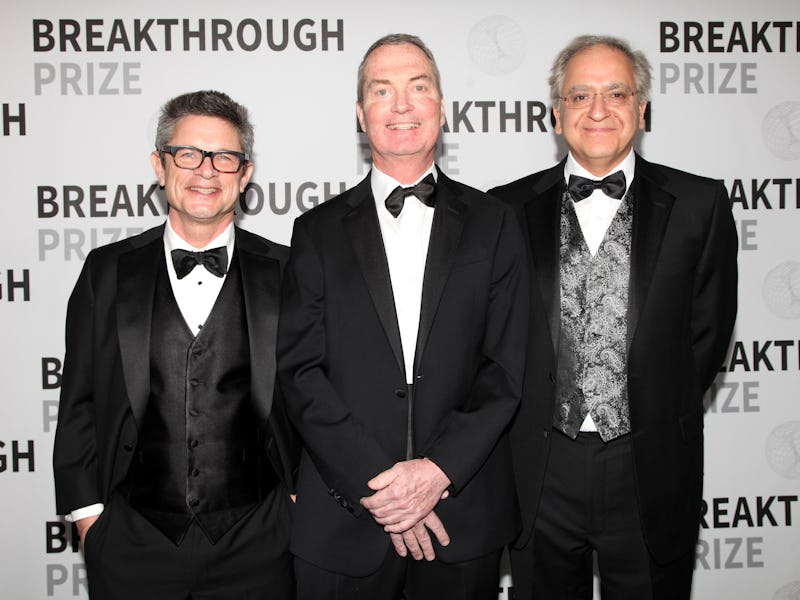
The Breakthrough Prize ceremony is the rare event where Hollywood celebrities cheer on while brilliant scientists are awarded millions of dollars. Known as the “Oscars of science,” Sunday night’s gala celebrated the advancement of scientific concepts like gravitational waves, string theory, and cancer research. Despite stereotypes perpetuating the contrary, scientific genius and great style can go hand in hand, as three award-winning fundamental physicists clearly demonstrated on the red carpet.
Founded by the STEM billionaire dream team of Sergey Brin, Anne Wojcicki, Yuri and Julia Milner, and Mark Zuckerberg and Priscilla Chan, this year’s Breakthrough Prizes totaled in an allocation of $25 million. A testament to Yuri Milner’s dream that scientists get treated like rockstars, the Morgan Freeman-hosted ceremony was a red carpet affair where physicists and geneticists got the celebrity treatment. Here are some of the hottest looks of the hottest researchers in the game:
Physicists Andrew Strominger, Cumrun Vafa and Joseph Polchinski.
Joseph Polchinski, Andrew Strominger, and Cumrun Vafa are fundamental physics #squadgoals. They don’t just make James Bond look like a slob; on Sunday, they walked away with the 2017 Breakthrough Prize in Fundamental Physics, sharing the $3 million prize. The trio was awarded for advancing what we know about string theory, how it can explain the inner workings of black holes — and, you know, the universe. Specifically, Polchinski studies what happens to information that goes into a black hole, figuring out in 1995 that string theory can include two-dimensional objects. In 1996, Strominger and Vafa were able to compute and confirm the Stephen Hawking hypothesis that black holes can leak radiation and explode.
Breakthrough Prize in Life Sciences Laureate Huda Zoghbi (right) and William Zoghbi (left) attend the 2017 Breakthrough Prize at NASA Ames Research Center.
Dr. Huda Zoghbi is not only glam as hell but a professor of pediatrics, molecular and human genetics, neurology, and neurosciences at Baylor College of Medicine. She won $3 million as one of this year’s Breakthrough Prize in Life Science recipients — an event she told the The Guardian “totally stunned” her. However, Zoghbi shouldn’t have been stunned because the research she’s doing is absolutely incredible: Zoghbi has discovered that a mutated gene, SCA1, causes the neurodegenerative disorder Spinocerebellar ataxia. Currently, the disorder, which affects an estimated 150,000 people within the United States, can’t be treated — but her findings may lay the groundwork to ultimately finding a cure.
Mathematician Jean Bourgain attends the 2017 Breakthrough Prize.
Belgian mathematician Jean Bourgain won the 2017 Breakthrough Prize in mathematics. When he’s not rocking a pocket square on the red carpet, Bourgain is slaying the mathematics game, publishing an average of 10 papers a year. Most recently, he developed a “decoupling theorem”, which The New York Times describes as a “very abstract generalization of Pythagorean’s theorem applied to oscillating waves like light or radio waves*.
Rebecca and Dr. Rainer Weiss attend the 2017 Breakthrough Prize at NASA Ames Research Center.
With his tuxedo-bow tie combination, Dr. Rainer Weiss looked like Humphrey Bogart if Humphrey Bogart had ever changed what we knew about the universe. Rainer won the Special Breakthrough Prize in Fundamental Physics with the other two founders of the LIGO team, Ronald Drever and Kip Thorne, as well as 1,012 other scientists on the LIGO team. In May, Weiss and his team announced that LIGO (the Laser Interferometer Gravitational-Wave Observatory) had successfully detected gravitational waves from colliding black holes. The discovery proved Albert Einstein’s general theory of relativity, which says that massive accelerating objects could create “waves” in space and that the ripples of these waves would travel through the universe at the speed of light. According to LIGO’s site, these waves “carry with them information about their cataclysmic origins, as well as invaluable clues to the nature of gravity itself.”
With a third of the $3 million prize split between Weiss, Drever, and Thorne — and the rest spread evenly among the LIGO team — it is safe to say that the holiday party at LIGO is going to be cracking this year.